Vintage Treasures: The Budayeen Trilogy by George Alec Effinger
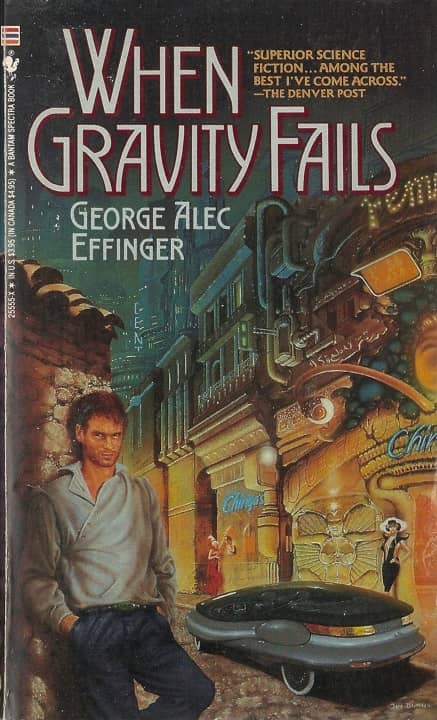 |
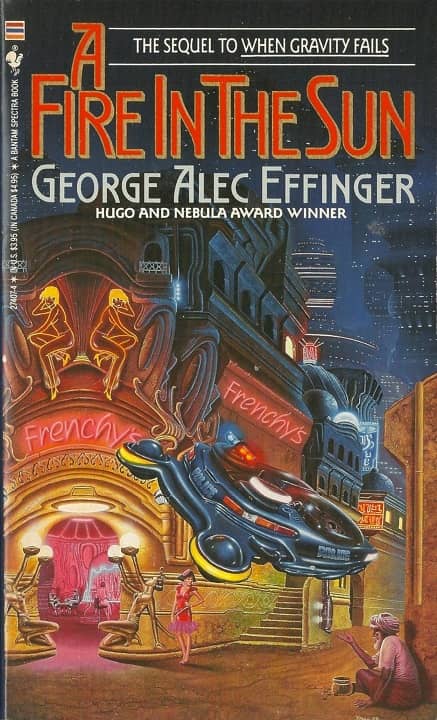 |
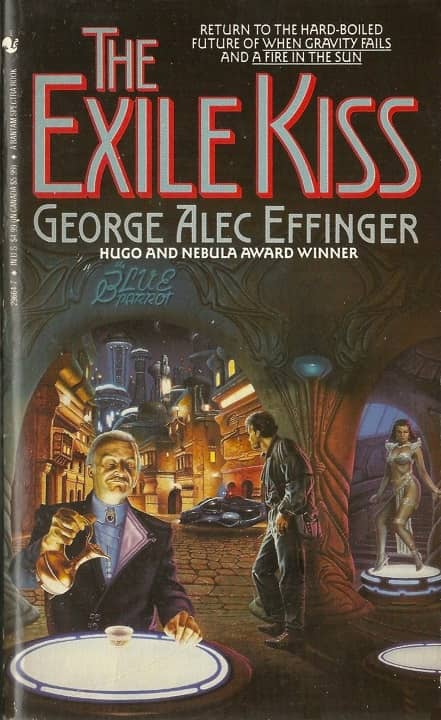 |
The Budayeen Trilogy: When Gravity Fails, A Fire in the Sun, and The Exile Kiss
(Bantam Spectra, 1988, 1990, and 1992). Covers by Jim Burns (When Gravity Fails), and Paul Youll & Steve Youll
George Alec Effinger’s Budayeen trilogy, sometimes called the Marîd Audran trilogy, is one of the enduring early classics of cyberpunk.
It had its birth in his short story “The City on the Sand,” originally published in the April 1973 issue The Magazine of Fantasy and Science Fiction. It was his first story set in the futuristic walled city of Budayeen, the city in the sand, a place of dark shadows and even darker inhabitants. Eventually Effinger set nine tales in Budayeen, including his most famous story, the Hugo and Nebula Award-winner “Schrödinger’s Kitten,” and all three of his most popular novels: When Gravity Fails (1987), A Fire in the Sun (1989), and The Exile Kiss (1991), featuring the street-smart detective Marîd Audran.
[Click the images for cyber-sized versions.]
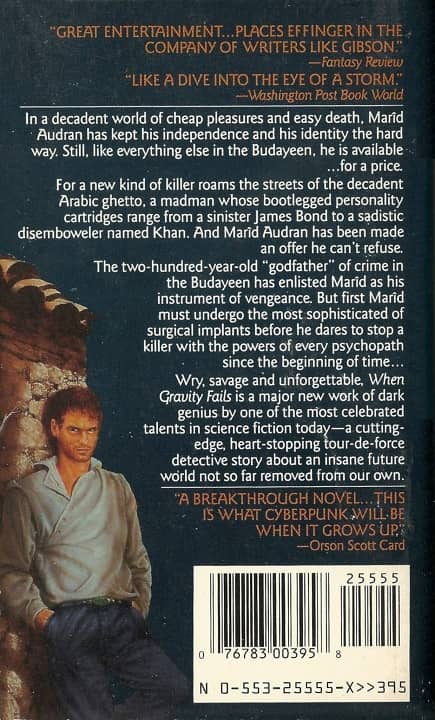 |
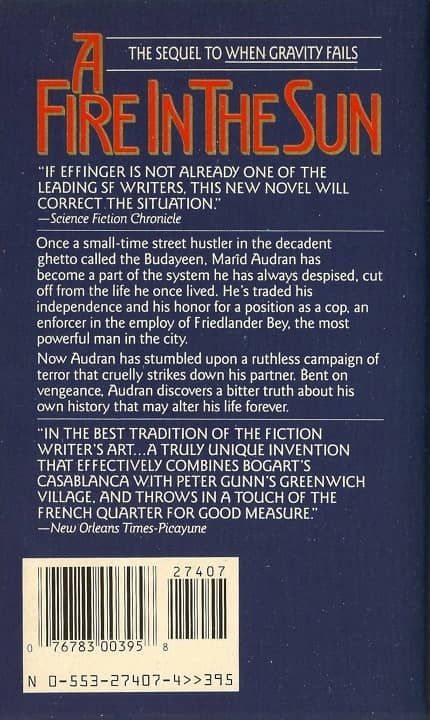 |
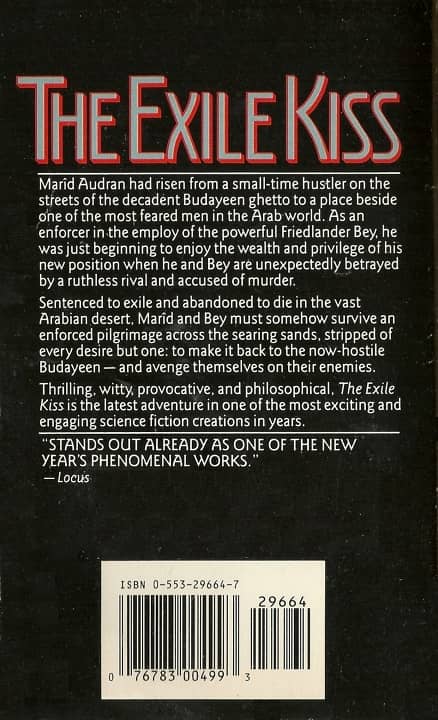 |
Back covers of the Bantam Spectra editions of the Budayeen Trilogy
What’s the trilogy about? Here’s a synopsis of the first volume from the PorPor Books Blog.
When Gravity Fails can rightfully be considered a First Generation Cyberpunk novel, one standing alongside Neuromancer, Dr. Adder, Hardwired, and Metrophage… Gravity certainly can be regarded as the first novel to mix cyberpunk with the detective/private novel; it is the forerunner of such later novels as the Carlucci series by Richard Paul Russo and Noir by K. W. Jeter.
Gravity is set… in the red-light district known as the Budayeen. Along with brothels, bars, shady merchants, and myriad tourist traps, the Budayeen offers a relaxed attitude towards vice and crime, albeit with the tacit approval of the authorities.
Marid Audran is a young Arab man who earns a living as a fixer and go-between among the personalities in the Budayeen. Marid’s worldly aspirations are modest:, and centered on earning enough money to maintain an apartment, a girlfriend, regular forays into the local night life, and a drug habit.
As the novel opens, Marid has been contacted by a Russian exile, who is seeking to hire someone to find his son, presumed to be in hiding among the narrow streets and alleys of the Budayeen. Hardly has the meeting between the Russian exile and Marid begun, then events take a violent turn. What at first seems to be a random series of particularly brutal, sadistic murders may in fact be the work of a serial killer, and Marid’s friends and acquaintances may be among his prey.
When Friedlander Bey, the ‘big boss’ of the Budayeen, decides that the murders are disrupting the district’s profitability, he approaches Marid with an offer that is not meant to be refused. For Bey wants Marid to be surgically altered, outfitted with neural implants that accept ‘mods’ – computer chips containing personality profiles of persons both real, and fictitious. Once equipped with his new implants, Marid’s task is to track down and eliminate the killer. But time is running out, for there is evidence that Marid himself is next on the list for elimination…..
The near-future Budayeen, with its eclectic mix of Muslim piety and crass commercialism, is an offbeat locale, one that stands out from the generic East Asian metropolises usually encountered in cyberpunk works. The novel’s large cast of characters is handled in a deft manner, and the incorporation of the private eye/noir elements of the plot is done with the right notes of sardonic humor.
When Gravity Fails was nominated for both the Hugo and Nebula award, and came in second in the voting for Best SF Novel of the year in the poll for the Locus Award. A Fire in the Sun won the 1990 SF Chronicle Award and came in second in the Hugo ballot; The Exile Kiss made the preliminary ballot list for both the Hugo and Nebula.
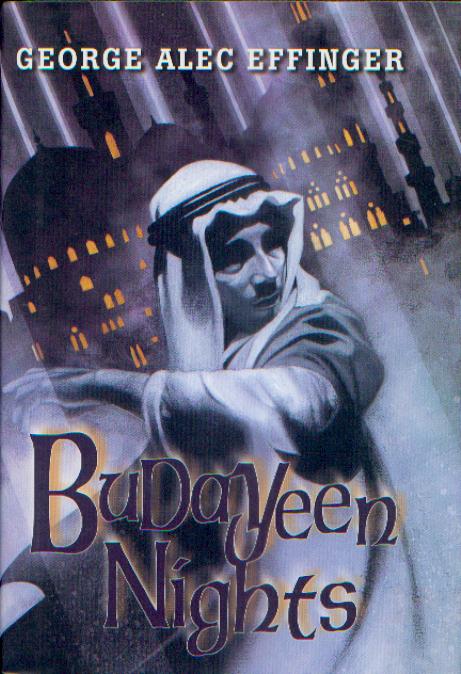 |
 |
Budayeen Nights shot story collection (Golden Gryphon hardcover edition,
September 2003, cover by John Picacio, and Open Road Media digital edition, 2014)
There’s been a lot written about these novels, and the Budayeen stories in general, but I find the most insightful words come from Effinger’s third wife, fantasy novelist Barbara Hambly.
Writing with brutal honesty in her introduction to the collection Budayeen Nights, published shortly after his death in 2002, Hambly lays out the dark source of inspiration for When Gravity Fails, and for the flawed character of its protagonist.
The setting of the Budayeen came about quite naturally, and is intrinsic to the writing of Gravity. George had a very dark side to his nature, a fascination with the underworld and the demimonde that came about, I think, because many of his mother’s friends were hookers and strippers back in Cleveland: he used to go and watch them dance when he was in his early teens. Maybe this was why he was so comfortable in the shadow-world of New Orleans… He was good friends with a lot of the denizens of that world, including a sexchange named Amber who took the wrong man home one night and ended up being beaten to death and thrown off a balcony.
The New Orleans police being what they were, no investigation was made.
George’s outpouring of outrage and helplessness became When Gravity Fails. He set it in the nameless Muslim city he’d invented for [his 1973 short story] “The City on the Sand” — which became a pay-the-medical-bills book called Relatives — because some of the characters were based on real people, including the local Mafia boss. But when you read it, it’s obviously the French Quarter, with maybe a little of the East Village in the sixties where George lived after dropping out of Yale. Being George, he studied Islamic culture extensively, so as not to inadvertently insult those whose world it actually is….
George intended Gravity as a one-shot, but when it took off in popularity and Bantam asked him to do a second book, he found he did have another novel-length tale to tell of that universe, based around the death of his own grandfather, a Cleveland policeman who was killed in the line of duty. He said the Budayeen was the first world he’d created that had depth and richness, whose characters lived lives of their own…
His protagonist, Marîd Audran, fascinates and charms because he, too, is real — or as real as things get in the Budayeen. George said frankly that, like the hapless science fiction writer Sandor Courane of some of his other tales, Marîd is based on himself. It amused George that many readers take Marîd at Marîd’s own evaluation of himself: cool, clever, street-smart, sharp. But in fact, George said, if you look at what Marîd actually does rather than what he says, he is in fact cowardly, not nearly as clever as he thinks he is, and has a major drug problem which he never quite gets around to addressing.
Like George — dearly as I loved him.
Barbara Hambly also provides an intro and commentary for many of the individual stories, including “The Plastic Pasha,” a fragment begun just days before Effinger’s death, which PW calls “barely an excerpt, but pungent and alive.”
Here’s more from the Publishers Weekly starred review of Budayeen Nights.
One of the founders of cyberpunk, Effinger (1947–2002) led a pain-filled life, but one would never know of his suffering from the tales in this brilliant collection, full as they are of antic humor and atmospheric inventiveness. All nine selections — seven stories, the first portion of an uncompleted novel and a story fragment — are set in his marvelously realized, imaginary Muslim city of Budayeen… Marîd Audran, the chief protagonist in these stories, like everyone else in the 22nd century, wears brain-implant plugs, enabling him to snap in and experience “moddies,” for pleasure or otherwise. The former is supplied by Honey Pilar, sex goddess of “Slow, Slow Burn,” whose super-provocative moddies are shared, with or without partners, by millions. In “Marîd Throws a Party,” the projected opening of Word of Night, a fourth Budayeen novel, Marîd is disconcerted when his adoptive grandfather, the powerful Friedlander Bey, announces he’s giving him the unwelcome gift of a new set of implants. In “King of the Cyber Rifles,” these implants are used for war purposes.
The Marîd Audran trilogy was reprinted in trade paperback by Orb in 2005/2006 with matching covers by Craig Mullins, and in digital editions from Open Road Media in 2014.
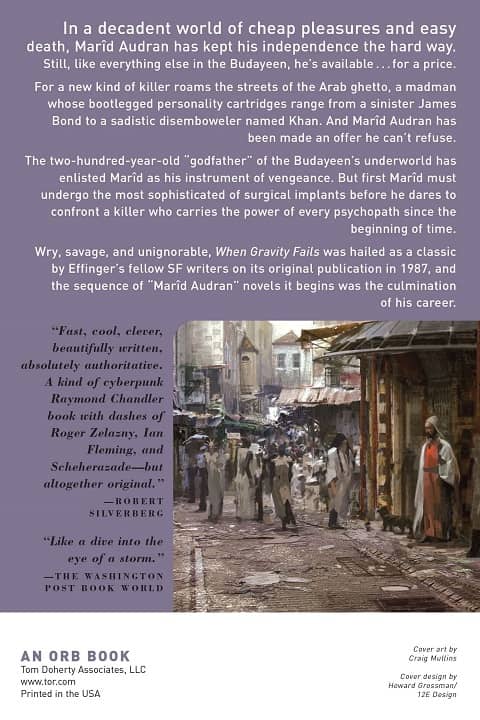 |
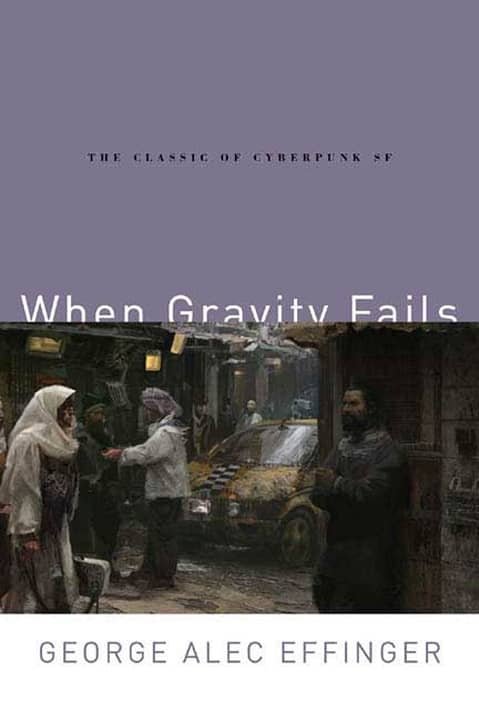 |
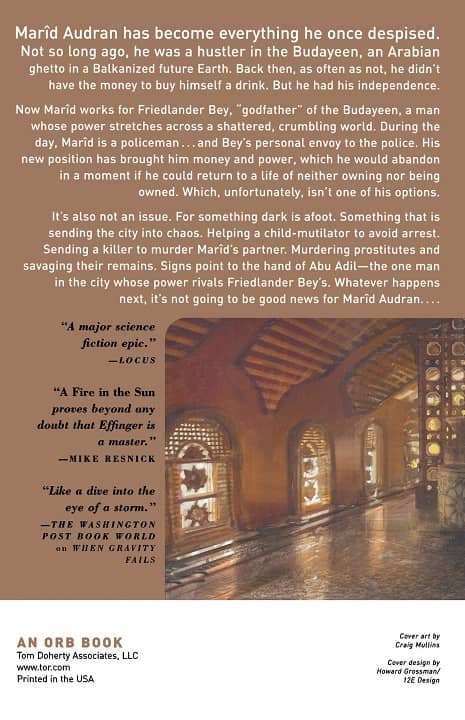 |
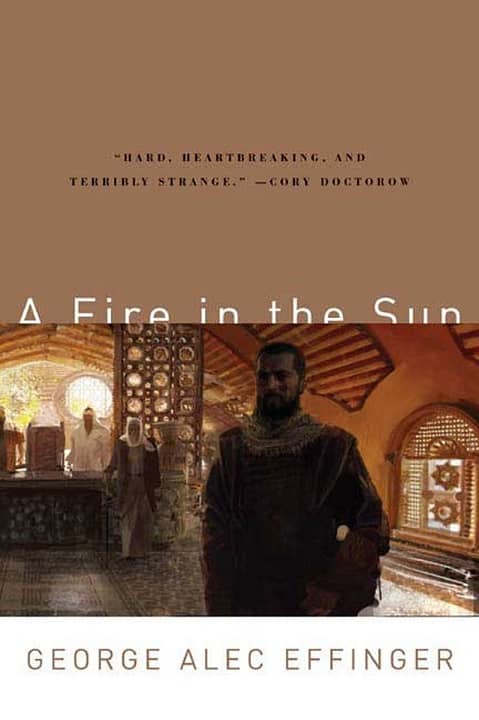 |
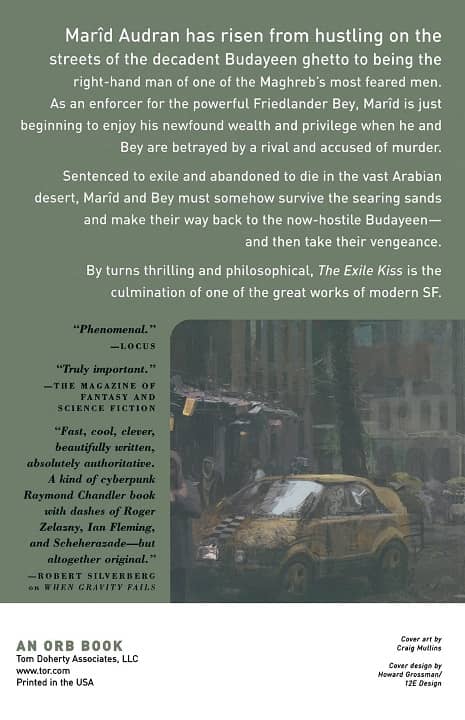 |
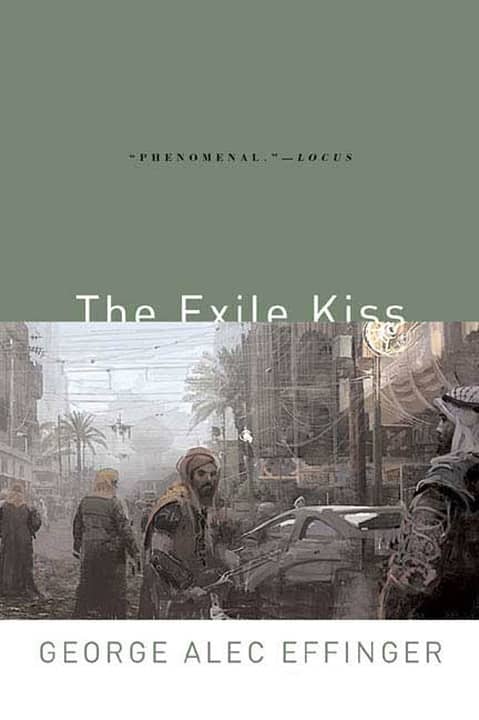 |
The handsome Orb trade paperback editions, with matching covers by Craig Mullins
His obituary in The New York Times focused chiefly on his short fiction.
Mr. Effinger was born in Cleveland and grew up poor. He earned a scholarship to Yale, where he went in the 1960’s intending to become a doctor. He dropped out twice and never received a degree.
He moved to the East Village in New York and met the science fiction writer Damon Knight, who became his mentor. He began publishing stories in magazines, then had a hit with his first book.
He had a knack for picking up a variety of styles and making them his own, said Harlan Ellison, a science fiction author and friend of Mr. Effinger.
”George was a genre unto himself,” Mr. Ellison said. ”They called him a fabulist, but he could write the New Wave or he could write pure fantasy or mystery.”
Mr. Effinger was perhaps best known for a series of stories featuring Maureen Birnbaum, a shopping-crazy teenager dropped into settings and situations that parodied science fiction. The stories were collected in 1993 in Maureen Birnbaum, Barbarian Swordsperson.
Our previous coverage of George Alec Effinger includes Steven H. Silver’s birthday review from 2018:
Birthday Reviews: George Alec Effinger’s “Albert Schweitzer & the Treasures of Atlantis” by Steven H. Silver
Here’s the complete publishing details for the Bantam Spectra paperback editions of the Budayeen trilogy.
When Gravity Fails (276 pages, $3.95 in paperback, $9.99 in digital formats, January 1988) — cover by Jim Burns
A Fire in the Sun (290 pages, $3.95 in paperback, $9.99 in digital formats, April 1990) — cover by Paul Youll and Steve Youll
The Exile Kiss (318 pages, $4.99 in paperback, $9.99 in digital formats, March 1992) — cover by Paul Youll and Steve Youll
The Orb editions were published in 2004/2005 in trade paperback with covers by Craig Mullins; the Open Road Media digital editions were published in 2014.
See all our previous Vintage Treasures here.
Those Orbs are still in print and available from you know who – time to get a paper route!
Thomas,
Indeed they are. I treasure my Bantam Spectra paperbacks of course, but those Orb volumes are still tempting. They’d look darn good on my shelf!
Thanks John–was hoping you’d get to these at some point after seeing them in that photo you shared a few weeks ago.
Loved these books–I hope they never go out of print!
I’ve been meaning to get to them for a while, Lou. I just had to make sure I had enough time to do them justice.
Lots more to get to in the pipeline. That stack of books next to my chair won’t write up itself.
Have you ever read the novel Hambly mentions above, RELATIVES? I wasn’t aware of it, but her mention made me curious.
i love these books, this is exactly the type of books i love. i mean i love a lot of books, but this is my all time favorite genre.
Cyberpunk mystery/noir, you mean? There’s not a lot of books that fit that genre. The PorPor blog mentions a few above (“the Carlucci series by Richard Paul Russo and Noir by K. W. Jeter,”) to that list I would add:
Synners by Pat Cadigan (1991)
Trouble and Her Friends by Melissa Scott (1994)
Altered Carbon by Richard Morgan (2002)
Moxyland by Lauren Beukes (2008)
The Quantum Thief by Hannu Rajaniemi (2010)
Infomocracy by Malka Older (2017)
Company Town by Madeline Ashby (2016)
In terms of recent books, the series that most puts me in mind of Effinger’s Budayeen books is Dan Stout’s CARTER ARCHIVES trilogy:
https://www.blackgate.com/2021/12/13/emthe-carter-archivesem-by-dan-stout/
What did I miss??
thanks for the list, i appreciate it! i have read quite a few of these, but i am ALWAYS on the lookout for the “future detective/cyberpunk mystery stories out there. i feel like since the video game (that was poorly received) there has been an uptick, especially in short stories, of the genre.
I read these when they first came out. Great series of books
You were well ahead of me, David. I didn’t catch on to them for over a decade.
There was a neat video game made based on the first story – “Circuit’s Edge” and got it in a multi-games pack (with Tongue of the Fatman aka Mondu’s Fight Palace!) at Costco. It was a fun game but a bit too limited by the tech of the time. That was how I found out about these stories so like a movie the adaptation might be so-so or horrid but “Even the worst movie is seen by more people than read the best book” and “The book is always better than the Movie” – the rule vs exception as Jodorowsky was never able to make his DUNE… (with 2x the Star Wars budget and a modern computer for CG effects delivered by a Time Traveler) Beagle and Aul got nuclear mad and sued over 75% to 85% their works – by contrast John Norman had 5% Gor movies but they kept on the VHS rental shelves for decades and kept his name / fictions relevant till the internet allowed him to jump the blacklist and sell direct and digitally!
I read When Gravity Fails when it first came out and had stopped spending as much time in book stores about 1988 so I didn’t even know about the sequels until the mid 90s.
Oh how I loved the Marid Audran series, and for the most part, try to read it every couple of years. Great Stuff like this deserves to be read and reread, and shared and reshared.
Thanks for sharing JLB. I’ve had a few folks ask me if they think this series would make a good modern TV series for HBO or Netflix…. you seem like the guy to ask. 🙂
I never caught these when they came out, but this post intrigued me so much I bought the Orb edition of When Gravity Fails (have Amazon send you your kickback, John) and just finished it today. It’s not my usual cup of tea, but I enjoyed it a lot and will be picking up the other two books, inshallah. (I love books that teach me useful new words and phrases.)
Hey Thomas — you know what we haven’t seen in a while? One of your deeply informed and highly entertaining reviews. Just saying. 🙂
Well, at the moment I’m knee-deep in a piece on that ABC Movie of the Week…er, “classic”, Satan’s School for Girls. I don’t know whether you – or anyone else – will consider that good news or not…
My favourite series of all time. I bought them as they came out and I reread them every couple of years.